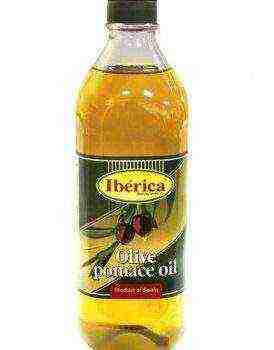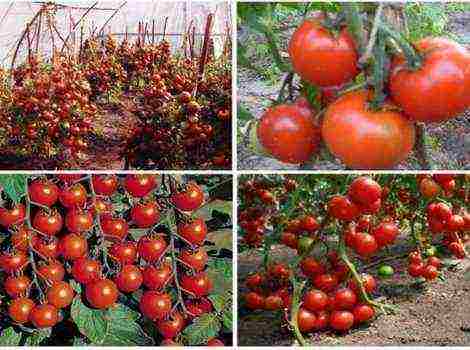Content
This page presents the best varieties of cluster tomatoes. Among them are tomatoes for greenhouses and for open ground.
The fruits of these varieties grow in both small and simply huge clusters, or, as many say, in clusters. Most of them are suitable both for pickling and canning, as well as for fresh consumption.
Click on the variety you are interested in, a page will open, which gives a description of the variety or hybrid, a photo of the whole bush or individual tomatoes, the seller of the seeds of this tomato, and perhaps the reviews of those who planted them.
We hope that all this information will help you choose the best cluster tomatoes to plant.
Happy viewing.
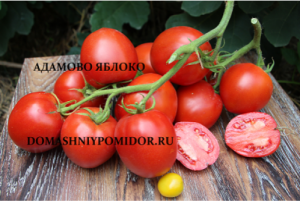 Tomato Adam's apple
Tomato Adam's apple
Mid-season, indeterminate, tall, bristle tomato variety for greenhouses and open ground. A bush up to 1.8 meters high, a leaf of the usual type. A garter to the support and pinning is required. Nailu ...
TomatLand1 436 views0 comments
Tomato Adeline
Mid-season, determinant, undersized, high-yielding tomato variety for open ground and film shelters. A bush with a height of 0.4-0.5 meters, which does not require pinching. A garter to the support is required. Per ...
TomatLand2 805 views2 comments
Tomato Adjutant
Mid-season, carpal, tall tomato variety for greenhouses and open ground. The period from germination to the beginning of ripening is 111-115 days. The bush is of an indeterminate type, 1.6-1.8 meters high. Required ...
TomatLand306 views0 comments
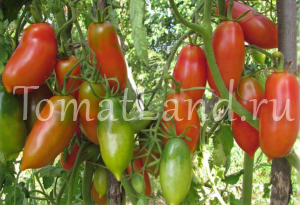 Tomato Scarlet candles
Tomato Scarlet candles
The fruits are collected in small clusters. Fruits are cylindrical, narrow, elongated, with a "spout". Dense, glossy, pink at maturity, weighing 60-100 grams. The taste is good, so they will do ...
TomatLand3 921 views12 comments
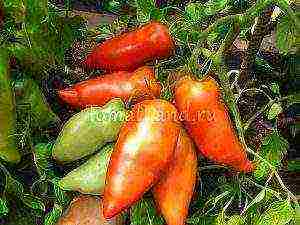 Tomato Scarlet Mustang
Tomato Scarlet Mustang
Mid-season, indeterminate, medium-sized bristle tomato variety for greenhouses and open ground. Low-leafed bush, 1-1.3 meters high. A garter to the support and pinning is required. The best ...
TomatLand6 504 views11 comments
 Red ragweed tomato
Red ragweed tomato
The original name of this tomato is Ambrosia red. Early maturing, indeterminate, tall cherry tomato for greenhouses and open ground. Variety originating from the USA. Bush up to 2 meters high ...
TomatLand276 views0 comments
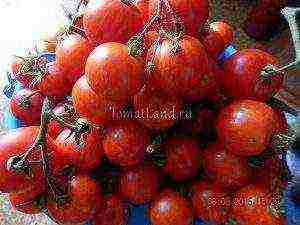 Tomato Amur tiger
Tomato Amur tiger
Medium early (108-112 days from germination to the beginning of ripening), a productive cluster tomato variety for greenhouses and open ground. The bush is beautiful, powerful, 0.8-1.2 meters high. The fruits are collected in a bunch of ...
TomatLand3 914 views8 comments
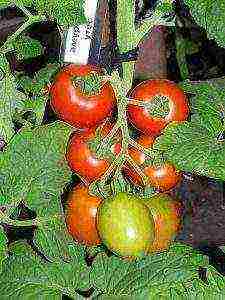 Tomato Amur Cliff
Tomato Amur Cliff
A mid-season, indeterminate variety with a height of 1.2-1.4 m, with dense fruits, plum-shaped, weighing 70-80 grams, red. Fruits do not crack, fleshy, dense, very tasty ...
TomatLand860 views0 comments
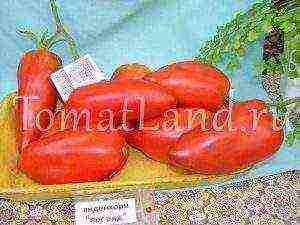 Tomato Andenhorn
Tomato Andenhorn
The original name of this tomato is Andenhorn. ANDENHORN - resembles paprika in appearance, rather large. The height of the bush is 1.3-1.5 m, requires a garter to the support. Fruits are red, weighing 100- ...
TomatLand591 views0 comments
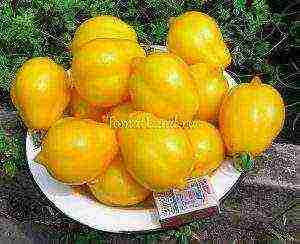 Tomato Anna German
Tomato Anna German
Indeterminate, mid-season, high-yielding, carpal tomato variety.Recommended for growing in greenhouses in the middle lane and in the open field in the southern regions. The bush is vigorous, spreading, high ...
TomatLand2 260 views1 comment
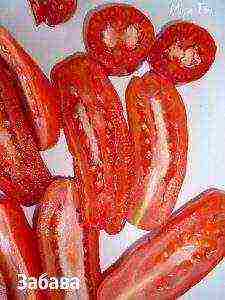 Tomato Auria
Tomato Auria
Very productive, indeterminate (unlimited growth), mid-season tomato variety. Liana bush, about 2 meters high. Requires a garter plant to a support or trellis and a stepson ...
TomatLand11 512 views20 comments
Tomato Banana red
Early maturing, determinant tomato variety for open ground and film shelters. The period from germination to maturation is 100-105 days. The height of the bush is 0.7-1 meter. Garter required p ...
TomatLand3 335 views4 Comments
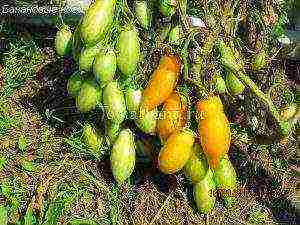 Tomato Banana Legs
Tomato Banana Legs
Mid-season, semi-determinant, high-yielding tomato variety. Recommended for outdoor cultivation. Bush up to 1 meter high, does not require pinching. Fruits - elongated cream (plant ...
TomatLand8 949 views8 comments
Tomato Banana
Medium early (103-110 days from germination to maturity), indeterminate, medium-sized, high-yielding tomato variety for greenhouses and open ground. A bush with a height of 1.5-1.6 meters (in a greenhouse), requires a garter ...
TomatLand1 385 views0 comments
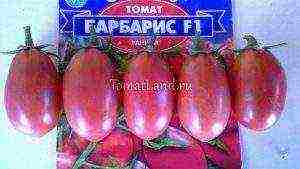 Tomato Barberry
Tomato Barberry
Early maturing, indeterminate hybrid of tomato for greenhouses. The height of the bush is up to 2 meters, the leaf is ordinary. A garter to the support and pinning is required. The best result is when the plant is formed in 2-3 ...
TomatLand2 266 views1 comment
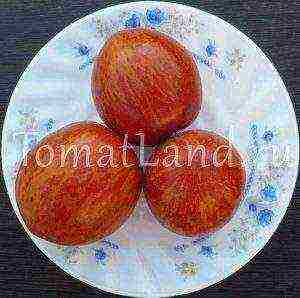 Tomato Velvet streaked
Tomato Velvet streaked
The original name of this tomato is Velue Striee. Mid-season, indeterminate, carpal, rare tomato variety from French breeders. Recommended for greenhouses and open ground. Bush oh ...
TomatLand828 views0 comments
The best fruit-bearing varieties of tomatoes for Siberian greenhouses are of no small importance for the people who grow them.
Selected varieties of elite tomatoes:
- produce fruits of standard size, which ripen at the same time due to genes that control ripening;
- have elongated brushes and sepals;
- tomatoes remain on the hands without overripe or fall off;
- even with a sharp change in temperature conditions, the fruits will not crack;
- the increased capacity of pectins in tomatoes contributes to their best preservation, especially if they have not been removed from the brush;
- the taste of tomatoes is sweet and sour, and the capacity of ascorbic acid in them only increases during storage.
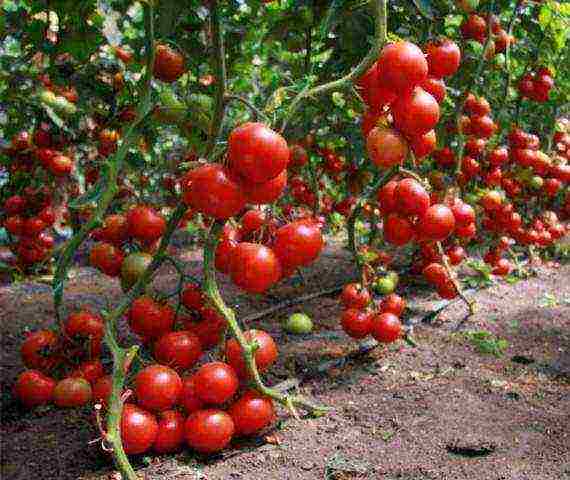
Features of growing bristle tomatoes
For seedlings, seeds are sown in light soil in March and sprinkled moderately with warm water from a spray bottle. It is necessary to dive the sprouts when the first leaf appears, after which they should be fed with a solution of mineral fertilizers. 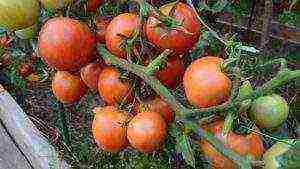 Young plants are transplanted into indoor ground at the beginning of May so that the ovaries appear at the end of June. Depending on the growth, mid-ripening tomatoes require a garter and removal of side shoots, and the bushes of early-maturing varieties form their crown on their own.
Young plants are transplanted into indoor ground at the beginning of May so that the ovaries appear at the end of June. Depending on the growth, mid-ripening tomatoes require a garter and removal of side shoots, and the bushes of early-maturing varieties form their crown on their own.
The soil under young plants is regularly loosened. Mulching helps to ensure a sufficient level of moisture: covering the ground under young plants with sawdust or straw to prevent it from drying out. For the prevention of diseases, the bushes are sprayed with special solutions of antifungal and antiviral drugs.
It is also recommended to ventilate the greenhouse more often, especially after watering, in this way the bushes are protected from dangerous late blight.
This fungal disease leads to the appearance of brown spots on the bushes and can destroy the entire crop in a short time. The collection of fruits is carried out when the color changes from green to brown. Such tomatoes will ripen at home and will not delay the ripening of the rest that are still on the brush.
By the time of ripening, carp tomatoes are subdivided into early and medium late. Tomato bushes are different in height, take different shapes and require different agrotechnical operations. Look at the article: The most popular varieties of tomatoes: a brief description of the varieties.
Early varieties
Tomato seeds are sown for seedlings at the end of March, grown plants are transplanted into large pots. Seedlings are rearranged every day to the light source on the other side, and starting in April, they are hardened, lowering the temperature. The seedlings are planted in the greenhouse in early May, without burying the stem into the ground. The following varieties are considered the most productive.
 Tomato Slot F1
Tomato Slot F1
The original tomato Slot F1 is used for planting in open ground because it does not react to temperature changes and does not crack. The excellent fertility of the bushes and the attractiveness of taste find their admirers among gardeners. The tomato can even withstand short-term drying of the soil and grow well in hot climates. Sometimes this variety can react poorly to feeding, and the fruits ripen on it quite late. For better formation, two stems are left on the bushes, which are attached to a support, otherwise the branches will break off under the weight of large fruits.
Tomato Gulliver
Positive reviews about Gulliver tomato of an early ripening variety for growing indoors are more common than negative ones. For better fruiting, two stems are left on the bushes, and the branches are tied up. This variety produces long-tasting fruits of excellent taste and allows, with regular watering and feeding, to begin harvesting from June to September. Tomato bushes resist viral diseases and do not require special care.
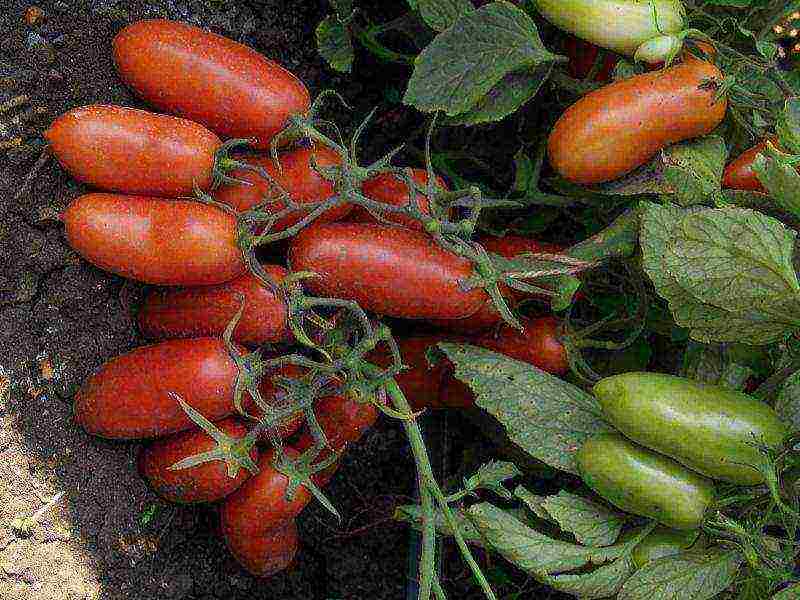
Tomato Gulliver
Tomato Klusha
Diverse reviews about the Klusha tomato, which ripens early, forms a low bush and does not need to be tied. The bush is formed into two stems, and after that it itself will take a form convenient for growth. A flat-round tomato of a small mass with low fertility, but it also takes up little space in the garden. The disadvantages of this variety include cracking of the fruit near the stalk under the influence of a sharp change in temperature.
Tomato Grozdevoy F1
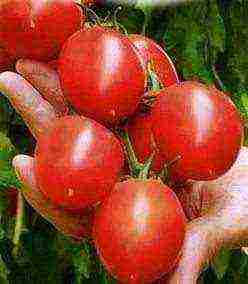 The original Grozdevoy F1 tomato is heat-resistant and resistant to temperature instability. It is a vigorous and strong plant. In one of the brushes, 8-9 fruits ripen at the same time, which contributes to a high yield. Tomato fruits form an elongated oval shape with a spout at the end and are distinguished by their extraordinary taste. The bush actively resists many fungal and viral diseases, and its fruits easily tolerate transportation, while maintaining their unchanged presentation.
The original Grozdevoy F1 tomato is heat-resistant and resistant to temperature instability. It is a vigorous and strong plant. In one of the brushes, 8-9 fruits ripen at the same time, which contributes to a high yield. Tomato fruits form an elongated oval shape with a spout at the end and are distinguished by their extraordinary taste. The bush actively resists many fungal and viral diseases, and its fruits easily tolerate transportation, while maintaining their unchanged presentation.
Tomato Juggler F1
A detailed description of the tomato Juggler F1 tells that inflorescences with 5-6 fruits are formed on the bush. The tomato tolerates a short-term rise in temperature and is highly fertile. Rounded tomatoes are transportable and store well.
Tomato baby sweet Cream
The popular Tomato Baby Sweet Cream has low compact bushes. They form growth on their own, therefore they do not require a garter and do not need pinching. Small fruits in the form of a plum have a sweetish taste, therefore they are very loved by children. In June, the bush completes fruiting and is removed from the garden.
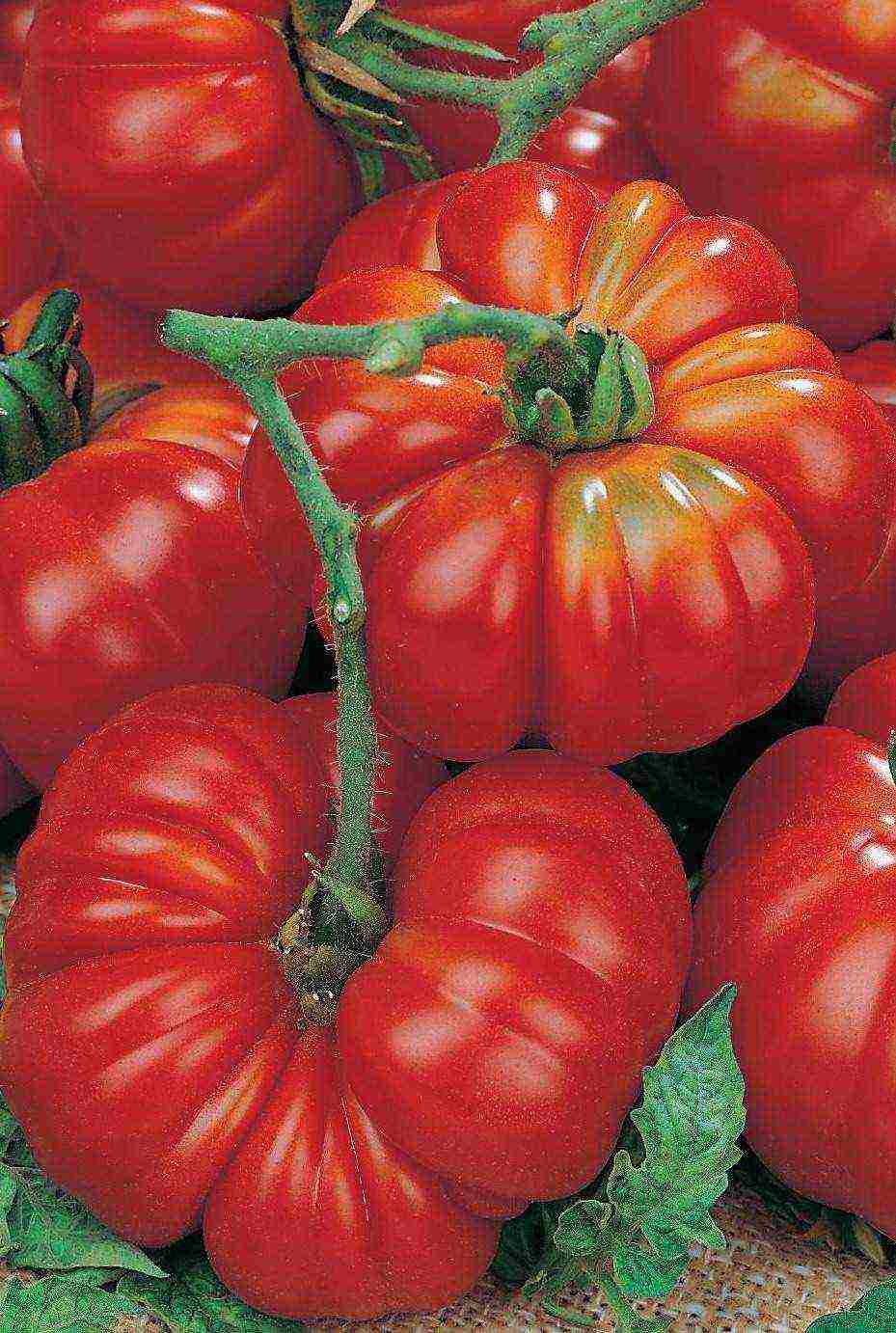 Tomato Female share F1
Tomato Female share F1
The in-demand tomato F1 female share ripens early. This is a large-fruited hybrid of the original ribbed shape. The long vine reaches a length of 180 cm, so only three ovaries are left on the brush for growing large tomatoes. Fruits of bright red color have excellent taste.
Tomato Sweet bunch
A detailed description of the tomato A sweet bunch informs that the bush reaches a height of up to 2 and a half meters, so it is tied to the trellis. A mandatory procedure is the removal of the stepsons and the vertical shaping of the bush. This variety of tomatoes guarantees long-term and abundant fruiting, pleasant sweet taste of the harvested fruits.
Tomato Firebird
High-yielding tomato Firebird with orange oval fruits, compact, cold-resistant and spreading. Provides medium fruiting, good shelf life and transportability.
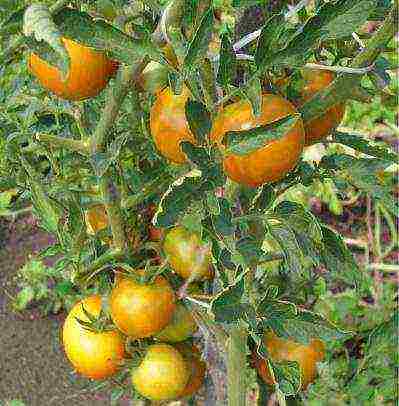
Tomato Firebird
Tomato Zhenechka
Fruitful tomato Zhenechka provides stable yields in any weather. Rounded, slightly ribbed fruits with a dense skin and a pleasant taste.
Tomato Elisha and Klondike
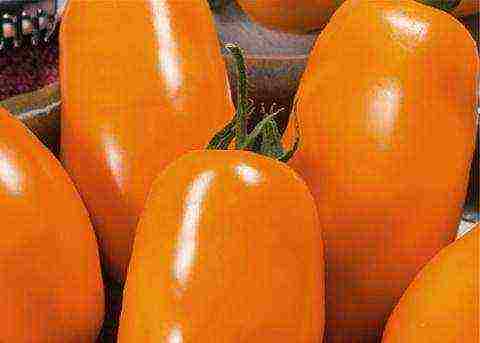 The early ripening tall tomato Elisha is left to grow in two stems on vertical trellises, and the stepsons and lower leaves are removed. Tomatoes have the appearance of an orange cylinder and have a sweetish taste.
The early ripening tall tomato Elisha is left to grow in two stems on vertical trellises, and the stepsons and lower leaves are removed. Tomatoes have the appearance of an orange cylinder and have a sweetish taste.
The original Klondike tomato forms a compact bush with rounded orange fruits.
Tomato King of Giants
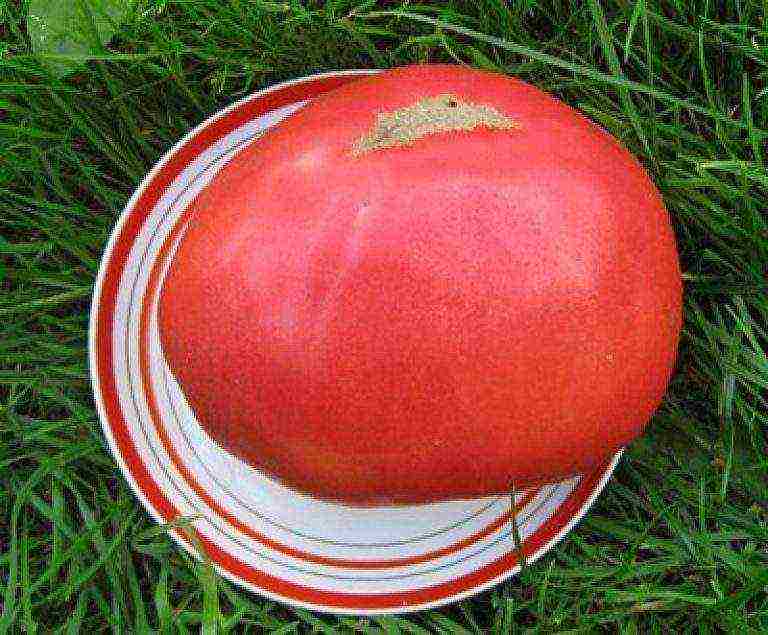 Positive reviews about the King of Giants tomato refer to the almost two-meter size of the bush and the weight of each of the fruits up to a kilogram. Such fruiting is achieved by the fact that no more than three ovaries are left in the brush and provide full watering and loosening of the soil. Fruitful bushes are planted in closed ground and try to protect them from sudden changes in temperature, which leads to cracking of the fruit.
Positive reviews about the King of Giants tomato refer to the almost two-meter size of the bush and the weight of each of the fruits up to a kilogram. Such fruiting is achieved by the fact that no more than three ovaries are left in the brush and provide full watering and loosening of the soil. Fruitful bushes are planted in closed ground and try to protect them from sudden changes in temperature, which leads to cracking of the fruit.
Greenhouse bushes of medium early fruit formation require abundant watering and the removal of the lower leaves after the appearance of ovaries. Large oval fruits of a slightly pressed shape are distinguished by delicate pulp and a sweetish taste. The plant can suffer from whitefly, therefore, for prevention, it is sprayed with Confidor solution. A variety of reviews about the King of Giants tomato can be found on the net.
Mid-season varieties of cluster tomatoes
Medium-ripened cluster tomatoes for greenhouses are mostly tall and often produce large tomatoes. In addition to weeding and loosening the soil, they need to remove side shoots and leaves below the ovary. After the eighth ovary appears on the bush, the top is removed to form larger fruits.
Tomato Jenaros F1
Excellent reviews of the Zhenaros F1 tomato inform that this tomato has especially large fruits. The shape of the fruit is round, the flesh is tasty, the density of the peel is high, so it does not crack. The mid-season variety is distinguished by high resistance to viral and putrefactive diseases.
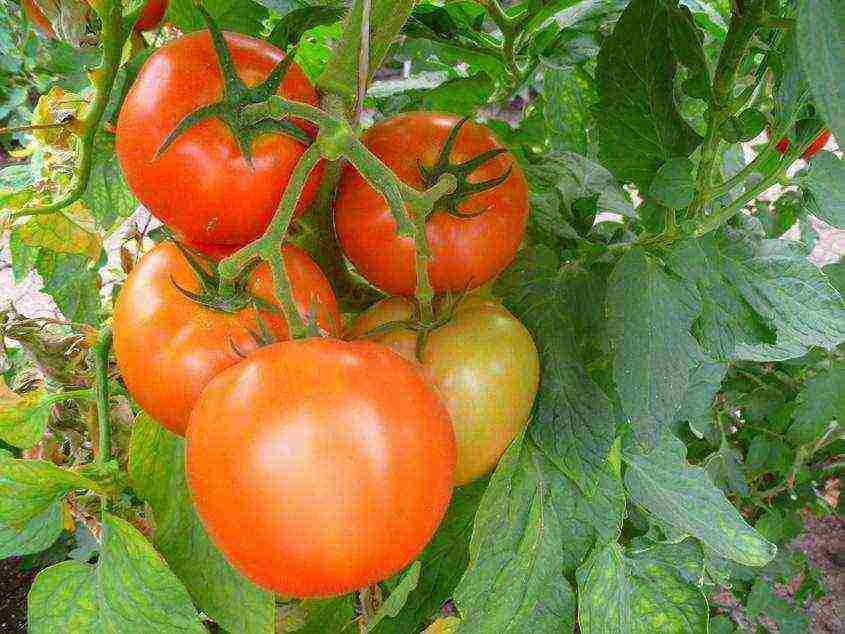
Tomato Jenaros F1
Tomato Strawberry Tree
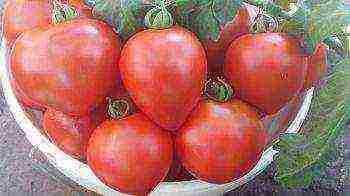 Various reviews of the strawberry tree tomato refer to the average ripening period of its fruits in greenhouses, but it can also be grown in open beds. It is famous for its high growth and excellent fertility, not susceptible to sudden changes in temperature. The bush is unpretentious and bears fruit for a long time. The only thing that he does not tolerate is prolonged drought. It can grow on soils poor in useful minerals. The fruits are bright red in shape, resemble strawberries and have a pleasant taste. Similar to the Strawberry Dessert variety. For whitefly and spider mites, spraying tomato with the drug "Confidor" is used.
Various reviews of the strawberry tree tomato refer to the average ripening period of its fruits in greenhouses, but it can also be grown in open beds. It is famous for its high growth and excellent fertility, not susceptible to sudden changes in temperature. The bush is unpretentious and bears fruit for a long time. The only thing that he does not tolerate is prolonged drought. It can grow on soils poor in useful minerals. The fruits are bright red in shape, resemble strawberries and have a pleasant taste. Similar to the Strawberry Dessert variety. For whitefly and spider mites, spraying tomato with the drug "Confidor" is used.
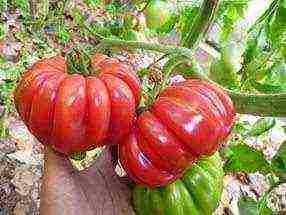 Tomato Mushroom Basket
Tomato Mushroom Basket
A detailed description of the tomato Mushroom basket informs about varieties with ribbed fruits. It is not only original, but also famous for the soft taste of the fruit. Tall tomato lianas (indeterminate variety) are attached vertically to the trellis and the lateral shoots are removed, which makes it possible to achieve an enlarged mass of fruits. The greenhouse variety is distinguished by excellent fertility, although it is very thermophilic and reduces the number of ovaries in cool weather. Pests are fought by frequent ventilation of the greenhouse and preventive spraying with a weak solution of potassium permanganate.
Tomato King of Kings
Positive feedback on the tomato King of Kings with a late fruiting date of this tall plant that is grown in two stems. It is tied to a vertical support, the pink fruit has a special taste.
Sweet Tomato
The original Slastena tomato for indoor, thermophilic and requiring a lot of sunlight and sufficient humidity. Then the rounded bright red fruits will delight you with excellent taste.
Tomato French bunch
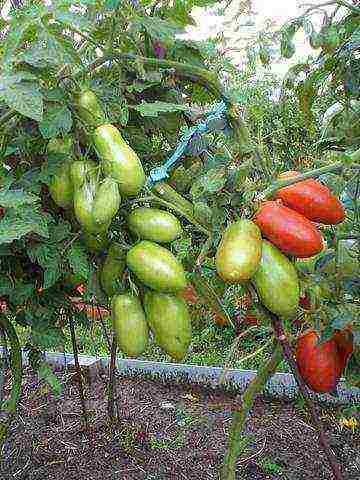 Various reviews about the French bunch tomato are forcing an increasing number of gardeners to grow this variety. Tomato seeds are sown in March in light soil.Seedlings are watered moderately and additionally illuminated in the evenings. A pick is carried out when a real leaf is fully developed, and feeding is immediately carried out with an aqueous solution of mineral fertilizers, including calcium and magnesium.
Various reviews about the French bunch tomato are forcing an increasing number of gardeners to grow this variety. Tomato seeds are sown in March in light soil.Seedlings are watered moderately and additionally illuminated in the evenings. A pick is carried out when a real leaf is fully developed, and feeding is immediately carried out with an aqueous solution of mineral fertilizers, including calcium and magnesium.
Young plants are planted in the greenhouse in early May so that the fruits set in June and immediately provide them with good support. The bright red oval fruits are characterized by juicy pulp and dense skin. These properties ensure long-term storage of the tomato and excellent transportability.
Tomato Zhigalo
Impressive reviews of the Zhigalo tomato are more about its sausage-like shape, these tomatoes are easy to stuff by removing a small amount of pulp inside the tomato.
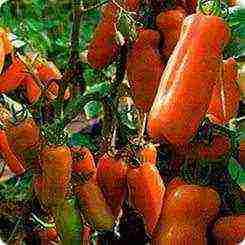 The mid-ripening tomato Zhigalo Biotechnika is specially designed for indoor use and is famous for its long and abundant fruiting.
The mid-ripening tomato Zhigalo Biotechnika is specially designed for indoor use and is famous for its long and abundant fruiting.
Clustered tomatoes form fruits that are standard in size. They are densely and evenly spaced on a long brush. Tomatoes ripen almost at the same time, do not crack and do not fall off. Early tomatoes are left to grow in two clusters and no longer form a bush. They do not need a garter either; they are only lifted off the ground.
Clustered tomatoes in greenhouses need abundant watering with warm water, regular ventilation and loosening of the soil. To protect against diseases, plants are sprayed with antifungal and antiviral drugs. With good care, tomato bushes will bear fruit for a long time and abundantly with tasty and beautiful fruits of various colors. We recommend viewing the article: Tomatoes on the balcony: growing the most common varieties.
Gardeners are increasingly planting carp varieties of tomatoes on their plots. Most of these plants are timed for indoor planting. They were bred to grow on a large scale - for industrial purposes. But ordinary summer residents also fell in love with them.
A distinctive quality of these tomatoes is that the fruits ripen on them almost simultaneously. They form a kind of bunch with many tomatoes, very decorative.
Bristle varieties have a number of advantages:
- high productivity;
- good gastronomic qualities;
- ripe tomatoes do not rot, do not fall off;
- can be collected in bunches.
The seeds are planted for seedlings. Sowing time depends on climatic conditions.
Among the carpal tomatoes there are indeterminate (tall) and determinant (undersized) plants. Indeterminate shrubs form, leaving one main stem. Determinant - in several stems. Tall bushes should be tied to trellises or pegs.
The cluster of such tomatoes can be simple, intermediate, complex or very complex. There are very few plants with a complex brush. One bunch can contain 30-100 tomatoes.
By the ripening period, tomatoes can be:
- ultra-ripe 80-85 days;
- early ripe 90-95 days;
- mid-season 100-115 days;
- late maturing 120-130 days.
For areas with a temperate climate, early varieties are better suited. Late ripening plants can be planted only in the south of Russia, or in greenhouses with additional heating.
The best cluster tomatoes are hybrids. Such tomatoes require a lot of attention. They are high-yielding, the fruits are beautiful, even, with a shiny skin, transportable, and are not subject to diseases. In terms of taste, hybrids are not inferior to other varieties. Stored well.
Hybrids are obtained by crossing two species. They are designated by the letter F1 (first generation), obtained by crossing. Hybridization is a difficult, time-consuming manual labor. The seeds of these plants are more expensive.
Best hybrids
Instinct F1
The hybrid is undemanding to lighting, refers to mid-season and tall. Weight can reach 110 g.
F1 loyal friends
The variety is early maturing, plant height up to 2 m. Tomatoes up to 100 g, the number of tomatoes in one bunch is 7-12. One bush can yield up to 9 kg of harvest. Ripe tomatoes are red in color.The hybrid is suitable for growing in the northern regions of Russia, it tolerates temperature extremes well.
Carpal F1
Undemanding to sunlight, gives a good harvest even in the north of Russia, tomatoes are poured up to 110 g.
Barberry F1
An early ripe, indeterminate carpal tomato is considered small-fruited, since each fruit weighing within 25 g. In one bunch there can be up to 50 pieces, the color is pink. Treat cherry tomatoes.
Intuition F1
An early variety, mature tomatoes can be obtained 110 days after sowing the seeds, they will weigh about 100 g, red. The hybrid can be grown in cold climates.
Comet F1
Pomodor has large fruits, red color and weight about 80 g. Bred by foreign breeders. Medium-sized, light-loving, bears fruit well in different natural conditions.
Red Star F1
Large-fruited tomato, its weight is about 110 g. A variety with an early ripening period, bears fruit well.
Hello! I want to choose cluster tomatoes for greenhouses. I have 2 of them, one of polycarbonate, winter. The second is a small film greenhouse. I would like to try different tomatoes, preferably the most fruitful ones. What do you advise? Interested not only in classics, but also in original varieties with pink or yellow fruits. Is it possible to plant tomatoes that are recommended for open ground in the greenhouse, or do you need to choose special varieties?
Good afternoon! Clustered tomatoes for greenhouses and open field are now in vogue. The fruits, harvested in long clusters, look very beautiful, besides, the harvest is convenient to harvest. Such tomatoes ripen together, so they are not cut one by one, but with a whole brush.
For greenhouses, it is advisable to choose first generation hybrids. They are fruitful, fully consistent with the declared qualities. Another important advantage of cluster tomatoes is their high resistance to typical diseases of the nightshade (late blight, cladosporium, fusarium wilt, apical or root rot, gall nematode).
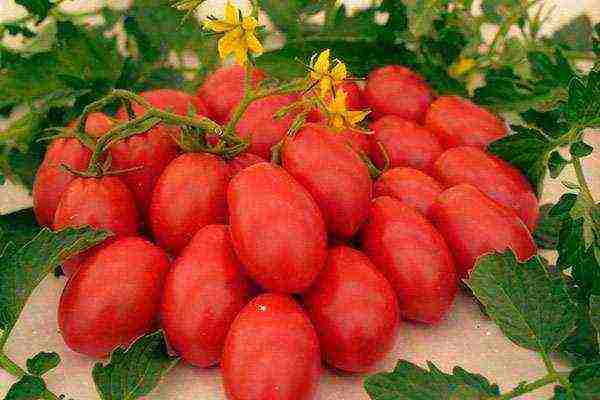
It is better to plant tall bushes of an indeterminate type in polycarbonate greenhouses; semi-determinant varieties are suitable for film greenhouses. For greater productivity, the plants will have to be pinned, it is more convenient to grow them in 1 or 2 stems, removing excess lateral processes. Bristle varieties require mandatory tying. It is convenient to attach them to trellises, tying not only the stems, but also heavy branches with fruits.
When choosing carp fruits, you need to decide which options are preferable. For canning, you need medium-sized tomatoes with dense skin. The productive variety Patron has proven itself well with round-cylindrical dense fruits. Cherry cocktail with small, very sweet tomatoes is also distinguished by its yield.
In film greenhouses, you can plant small-fruited Cio-Cio-San tomatoes with very large clusters. Excellent options for polycarbonate greenhouses or greenhouses are Bolero, Centaur, Eupator hybrids, suitable for canning and for salads.
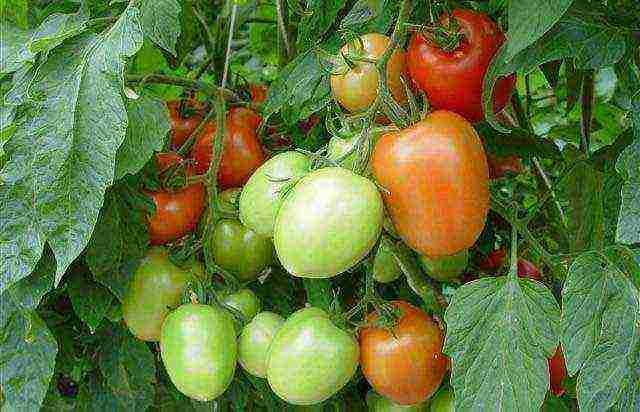
A separate category is very small cherry tomatoes. They can also be planted in greenhouses, their fruiting begins early and lasts until frost. When heated, it is possible to get fresh tomatoes even in late autumn. The promising hybrids of Businka, Waterfall, Dessert, Parrot, Queen Margo, Winter cherry are suitable. Clustered cherry tomatoes are distinguished by a pleasant sweet taste, beautiful appearance and impressive productivity.
It is enough to plant 2-3 bushes of each variety. After harvesting the first harvest, you can leave those that seem the most delicious and interesting.
In order for carp tomatoes to take root, it is important to follow the rules for caring for them. Tomatoes prefer potassium-based top dressing, moderate watering with warm water, and frequent airing of greenhouses.
